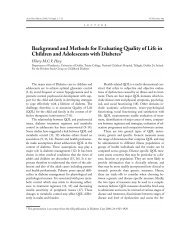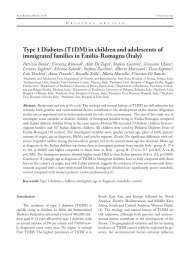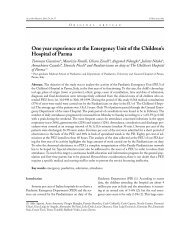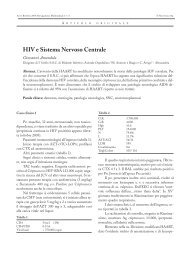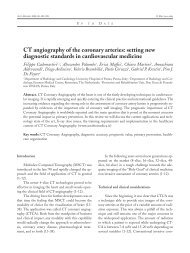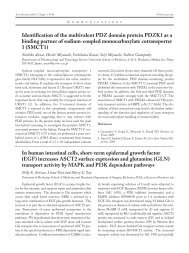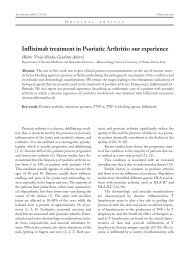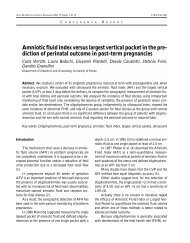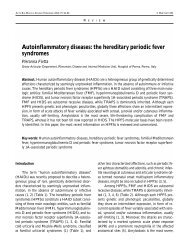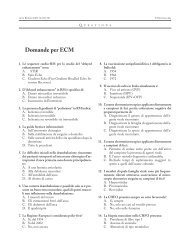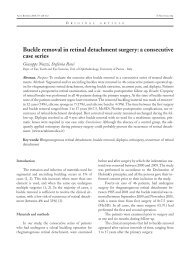Short reports+frontesp96-98 - Acta Bio Medica Atenei Parmensis
Short reports+frontesp96-98 - Acta Bio Medica Atenei Parmensis
Short reports+frontesp96-98 - Acta Bio Medica Atenei Parmensis
You also want an ePaper? Increase the reach of your titles
YUMPU automatically turns print PDFs into web optimized ePapers that Google loves.
114 <strong>Short</strong> Reports<br />
treated by lumbar sympathectomy, we observed complete<br />
remission in response to surgery in 29 (63%),<br />
while 7 were partial responders (15.2%) and 10 notresponders<br />
(21.7%). Conclusions: Broadly similar results<br />
were achieved with the two types of treatment.<br />
Both are indicated mainly in Fontaine stages IIB and<br />
III (non-advanced), particularly when revascularizing<br />
therapy proves impossible or excessively risky. The<br />
two strategies examined can be advantageously combined<br />
with direct revascularization surgery and may<br />
therefore constitute the first-line approach favouring<br />
subsequent therapy.<br />
Carotid endarterectomy under loco-regional<br />
anaesthesia: perioperative morbidity and<br />
mortality<br />
V. Piscitelli, K. Markabaoui, D. de Vito, P. Cutolo, F. Villa,<br />
S. Masone<br />
Department of General Surgery, Geriatrics, Oncology and Advanced<br />
Technologies, University of Naples “Federico II”, Naples,<br />
Italy<br />
Objectives: Cervical carotid stenosis is one of the<br />
main causes of ischemic stroke. Carotid endarterectomy<br />
is a safe procedure for treatment of moderate<br />
and severe symptomatic and asymptomatic carotid<br />
stenosis. Loco-regional anaesthesia for carotid artery<br />
surgery has many advantages over general anaesthesia.<br />
It may be associated with a reduction in neurological,<br />
and equally important, non-neurological morbidity<br />
and mortality. Materials and methods: From January<br />
2002 to December 2004, 128 patients were<br />
operated on their carotid arteries. Of these, 116<br />
(90%) patients and 136 carotid arteries were operated<br />
on in loco-regional anaesthesia and included in a prospective<br />
recording. The patients age ranged from 47<br />
to 100 years (mean 70.5 years), 85 patients were male,<br />
31 female. 45 patients (41%) were asymptomatic<br />
(Fontaine stage I), 41 have had a transient neurological<br />
deficit (TIA) prior to admission (Fontaine stage<br />
II) and 31 patients have had a stroke (Fontaine stage<br />
IV). All patients had carotid stenosis over 70%. Results:<br />
The combined stroke rate was 2.2% (n=3). The<br />
overall 30 day mortality was 0.8% (n=1). The rate of<br />
haematoma indicating revision was 3% (n=4). The revision<br />
in all cases was within 12 hours of surgery. No<br />
patient developed respiratory insufficiency after surgery.<br />
However, of the 4 patients with revision for haematoma,<br />
1 (10%) needed prolonged respiratory assistance<br />
and one patient ultimately died of respiratory<br />
insufficiency and stroke. No cardiac mortality was<br />
observed. The over all rate of myocardial infarction<br />
observed postoperatively was 1.4% (n=2), of which<br />
1.1% (n=1) were non q-wave infarcts. The combined<br />
shunting-rate for all stages was 18.6% (n=19). Conclusions:<br />
Morbidity and mortality of carotid endarterectomy<br />
in loco-regional anaesthesia is comparable to<br />
recently published single-centre results. Patients with<br />
severe COPD, usually unsuitable candidates for general<br />
anaesthesia, can also be treated safely. Our results,<br />
compared with the literature, show that endarterectomy<br />
is a safe procedure to treat moderate or severe<br />
carotid artery stenosis.<br />
Endoscopic surgery for treatment of nasal sinus<br />
polyposis in elderly patients: our experience<br />
A. Ranieri 1 , M.W. Rossetti 1 , E. Vetrano 2<br />
1<br />
Functional Unity Of Otorhinolaryngology, S. Rita Clinic,<br />
Atripalda (Av), Italy; 2 E.N.T. Clinic, II University of Naples,<br />
Italy<br />
At present, surgery is the elective treatment for<br />
nasal sinus polyposis; nevertheless, on the one hand a<br />
meticulous surgery reduces the percentage of recurrences,<br />
on the other hand there are cases in which<br />
even the most meticulous removal of the entire<br />
pathology cannot prevent the reappearance of polypus.<br />
Therefore recurrences wouldn’t appear so much<br />
linked to the type of surgery, rather onset appears<br />
linked to intrinsic, only partially recognizable factors<br />
responsible for the primary and secondary polypogenesis.In<br />
order to find an explanation for recurrences,<br />
different researches took into account different parameters<br />
(age, sex, severe deviation of the septum causing<br />
restriction, turbinate hypertophy) but all this did<br />
not prove to have any significance. The monolateral<br />
and bilateral implication of the sinus system doesn’t<br />
appear significant with regard to this, while ASA and<br />
NSAID intolerance and abundant eosinophilic infiltration<br />
in the mucous chorion proved statistically si-



